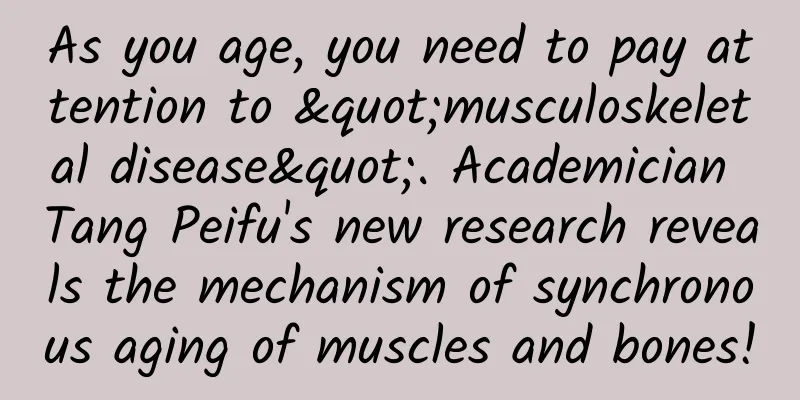As you age, you need to pay attention to "musculoskeletal disease". Academician Tang Peifu's new research reveals the mechanism of synchronous aging of muscles and bones!

|
With the surging tide of global population aging, osteoporosis and muscle atrophy (sarcopenia), a pair of "brothers in distress", have quietly become two major "roadblocks" on the road to health for the elderly. In China, the shadow of osteoporosis looms over 32.0% of the elderly over 65 years old, and the figure for women is as high as 51.6%. The aging of skeletal muscle and bone leads to a decline in muscle quality and function, as well as a decrease in bone density. These two conditions are collectively known as Sarcopenia-Osteoporosis Syndrome (SOS). Not only do they weaken the strength of bones and muscles, they also greatly increase the risk of falls and fractures, seriously threatening the ability of elderly patients to live independently. Sarcopenia-Osteoporosis Syndrome has a huge impact on the lives of the elderly, but current treatment options are still limited. Existing treatments focus on relieving symptoms and preventing fractures, such as using calcium and vitamin D supplements to increase bone density and using physical therapy to increase muscle strength. However, these methods can often only slow down the progression of the disease, but cannot fundamentally reverse the aging process of muscle and bone. Faced with this challenge, a research team led by Academician Tang Peifu, an academician of the Chinese Academy of Engineering and director of the Department of Orthopedics at the General Hospital of the Chinese People's Liberation Army, has provided us with a new perspective. An important research result of the team, Deciphering Immune Landscape Remodeling Unravels the Underlying Mechanism for Synchronized Muscle and Bone Aging, was published in the journal Advanced Science, revealing the remodeling of the immune landscape during muscle and bone aging, which may provide potential targets for the development of new therapeutic strategies. * By gaining a deeper understanding of changes at the cellular level during aging, scientists hope to develop treatments that can directly target these changes, thereby more effectively preventing and treating musculoskeletal diseases and improving the quality of life of the elderly. The research team led by Academician Tang Peifu first reviewed the existing knowledge about muscle and bone aging. They pointed out that the molecular mechanisms of synchronous aging of muscles and bones are not fully understood. Cruz-Jentoft and Sayer (2019) emphasized the serious impact of musculoskeletal diseases on the daily lives of the elderly, including increased risk of falls and fractures. Kirk et al. (2020) discussed the molecular mechanisms of muscle aging, while Compston et al. (2019) focused on the epidemiology and treatment strategies of osteoporosis. Karsenty and Olson (2016) proposed an endocrine coupling relationship between bones and muscles, which may play a role in the synchronous aging of muscles and bones. The above studies provide a basis for understanding muscle and bone aging, but have not yet fully revealed the changes at the cellular level during aging. The research team used single-cell RNA sequencing (scRNA-seq) technology to explore the cellular diversity and transcriptional dynamics of muscles and bones during aging, in order to reveal the potential mechanisms of synchronous aging. The team collected muscle and bone samples from people of different ages and analyzed cell types and transcriptional changes. They identified multiple cell types, including endothelial cells, fibroblasts, lymphocytes, mesenchymal stem cells, smooth muscle cells, satellite cells, myeloid cells, and lymphocytes. UMAP graphs show the distribution of different types of immune cells and age-related changes. Of particular note, the study revealed changes in myeloid cells during aging, especially the significant increase in TREM2+ macrophages in aging muscle and bone, which may be related to muscle atrophy and bone loss, indicating that these cells may play a key role in muscle and bone aging. This finding reveals key cell types and signaling pathways in muscle and bone during aging. Immunofluorescence staining Through immunofluorescence staining, researchers can observe the location and number of these cells in tissues and whether they change with age. The study found that genes related to muscular dystrophy and bone loss, such as secretory phosphoprotein 1 (SPP1), are highly expressed in TREM2+ Macs. This suggests that SPP1 may be a key molecule that plays a central role in muscle and bone aging, which provides important clues for understanding the mechanism of synchronous aging of muscle and bone. The study observed that in aged CD4+ T cells, there is a shift to a proinflammatory phenotype, which is activated by nuclear factor kappa B subunit 1 (NFKB1). In muscle, CD4+ T cells undergo Th1 cell-like differentiation, while in bone, a skewing toward Th17 cells was observed. This suggests that specific changes may occur in the immune system during aging, and these changes may be related to the aging phenotype of muscle and bone. The study highlights the role of BAG6-containing exosomes produced by degenerating cardiomyocytes in the synchronization of muscle and bone aging. These exosomes communicate with Th17 cells in the bones through their receptor NCR3, upregulating the expression of CD6 in Th17 cells. Subsequently, Th17 cells interact with TREM2+ Macs through CD6-ALCAM signaling, ultimately stimulating the transcription of SPP1 in TREM2+ Macs. This finding reveals a possible long-range intercellular communication mechanism between muscle and bone that may regulate the synchronized aging of muscle and bone during aging. Degenerating muscle delivers BAG6 through exosomes, which are transported through blood vessels and interact with Th17 cells in the bones. TREM2+ Macs promote osteoclast differentiation and bone resorption References: [1] Compston JE, McClung MR, Leslie WD. Osteoporosis. Lancet. 2019;393(10167):364-374. doi:10.1016/S0140-6736(18)31703-0. PMID: 30640958. [2] Cruz-Jentoft AJ, Sayer AA. Sarcopenia. Lancet. 2019;393(10183):2636-2650. doi: 10.1016/S0140-6736(18)32366-0. PMID: 30863398. [3] Karsenty G, Olson EN. Endocrine regulation of bone development and homeostasis. Cold Spring Harb Perspect Biol. 2016;8(6):a017219. doi: 10.1101/cshperspect.a017219. PMID: 27223286. [4] Kirk B, Zanker J, Duque G. Molecular mechanisms of muscle aging. J Cachexia Sarcopenia Muscle. 2020;11(1):609-620. doi: 10.1002/jcsm.12479. PMID: 31980573. [5] Yin P, Chen M, Rao M, Lin Y, Zhang M, Xu R, Hu X, Chen R, Chai W, Huang X, Yu H, Yao Y, Zhao Y, Li Y, Zhang L, Tang P. Deciphering Immune Landscape Remodeling Unravels the Underlying Mechanism for Synchronized Muscle and Bone Aging. Adv Sci (Weinh). 2024 Feb;11(5):e2304084. doi: 10.1002/advs.202304084. Epub 2023 Dec 13. PMID: 38088531; PMCID: PMC10837389. Written by: Xiaoyu Review: Shuxia Layout: Chu Han |
<<: Can doing eye exercises really prevent myopia?
>>: Tea Science | What are the health benefits of tea?
Recommend
How to treat the sequelae of a broken heart? How to get over the shadow of a broken heart after breaking up?
No matter who you are, no matter how strong you a...
How to heal cesarean section wound quickly
Caesarean section is more common among modern wom...
Normal progesterone value table for 10 weeks of pregnancy
Progesterone is a type of male hormone called est...
How do “sugar moms” cope with dietary challenges during the Spring Festival!
Author: Tian Ce, head nurse at Peking Union Medic...
What should I do if my vulva is itchy and has a burning sensation?
Nowadays, because the pace of life is too fast, s...
What is the origin of the order of the twelve zodiac signs? Which animal in the twelve zodiac signs wants to be the emperor?
The origin of the twelve zodiac signs is related ...
What to do if a 13-year-old girl has acne on her forehead
Most people who get acne on their foreheads have ...
Can vitamin C be taken regularly? Who needs to supplement vitamin C?
Vitamin C is an essential substance for maintaini...
Urethra prolapse after childbirth
After giving birth, there will be many adverse ef...
Do you know how to solve menopausal nipple pain?
Female friends, please take note: if you experien...
How to treat women's sweating
For women, sweating seems to be a very common thi...
Can gynecological diseases be diagnosed by TCM?
Nowadays, many people choose traditional Chinese ...
Is it easy for people with cold constitution to get pregnant?
Pregnancy is a very common situation in our lives...
Why do I always have stomach pain during ovulation?
Many young women report that they often feel lowe...
IDC: Global smartphone shipments are expected to grow 4% in 2024
According to IDC's Quarterly Mobile Phone Tra...









